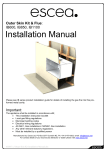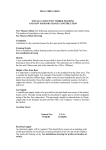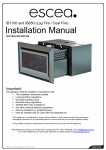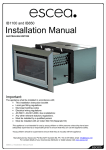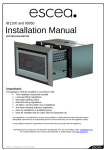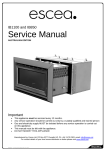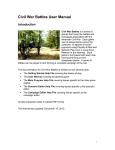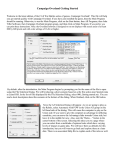Download Escea IB600 Installation manual
Transcript
IB1100, IB850, IB600 Installation Manual NEW ZEALAND EDITION Important: The appliance shall be installed in accordance with; • This installation instruction booklet • Local gas fitting regulations • Municipal building codes • Electrical wiring regulations • AS 5601 / AG 601—2000, Gas installations / NZ5261:2003 Gas Installation • Any other relevant statutory regulations. • Must be installed by a qualified person This appliance is not intended for use by young children or infirm persons unless they have been adequately supervised by a responsible person to ensure that they can use the appliance safely. Young children should be supervised to ensure that they do not play with the appliance. Manufactured by: Escea Ltd, PO Box 5277 Dunedin NZ, Ph: 03 479 0302, e: [email protected] G8860_4 Installation Manual NZ.doc 2 Note: THERE ARE FOUR MAIN THINGS TO CONSIDER BEFORE INSTALLATION • Cavity Dimensions & Clearances • Coupling of Flue to Fire • Coupling of Gas Lines to Fire • Fixing the Fire to the Cavity The sequences you choose to do these tasks will vary on your individual scenario. Please read these instructions fully before proceeding with your installation. Leave the installation of the fascia panels until the very end of the installation and commissioning to avoid damage to the fascia panels. WARNING: Failure to follow these instructions could cause a malfunction of the heater, which could result in death, serious bodily injury, and/or property damage. Failure to follow these instructions may also void your fire insurance and/or warranty. Installation: Installation must be carried out by a registered installer who, on completion of the installation, must issue a certificate of compliance, in accordance with national and/or local codes. If a certificate of compliance is not issued then the Escea warranty may be void. This appliance needs fresh air for safe operation and must be installed with provisions for adequate combustion and ventilation air available to the room in which it is to be operating. Warranty Repair and Annual Servicing: Warranty repair work must be carried out by a recognised Escea gas fire technician. It is recommended that recognised Escea Gas fire technicians are also used to carry out annual servicing requirements (particularly during the warranty period). For contact details of authorised Escea technicians in your area, please contact the retailer from whom the appliance was purchased. The heater must be installed according to these instructions and in compliance with all relevant building, gas fitting, electrical and other statutory regulations (eg. AS 5601 (AG-601), NZ5261). Any shortcomings in the appliance and flue installation will be the responsibility of the installer, and Escea will not be accountable for any such failings or their consequences. G8860 _4 Installation Manual NZ 3 Contents: Section: • Product Description 1.0 • Creating the Cavity 2.0 • Ventilating the Cavity 3.0 • Cavity Base 4.0 • Hearth 5.0 • Raised Installations Up a Wall 6.0 • Wall Linings 7.0 • Mantle Clearance 8.0 • Television Clearance 8.1 • Corner Installations 9.0 • Power Supply 10.0 • Installing the Flue System 11.0 • Laying Gas Pipe 12.0 • Assembling the Outer Skin Kit (IB1100 Only) 13.0 • Fixing the Outer Skin Kit to the Cavity (IB1100 Only) 14.0 • Inserting the Flue Support Bracket (IB1100 Only) 15.0 • Preparing the Heater for Installation 16.0 • Removing the Front Glass 17.0 • Connecting Flue to Heater 18.0 • Connecting the Gas Pipe 19.0 • Fixing the Heater to the Base and Wall 20.0 • Locating the Log Set 22.0 • Electrode Placement 23.0 • Checking Operating Pressure 24.0 • Fitting the Fascia Panels 25.0 • Locating Wall Mount Cradle for Wireless Control 26.0 • Normal Operating Sounds and Smells 27.0 • Installation Check List 28.0 G8860 _4 Installation Manual NZ 4 1.0 Product Description: The Escea IB1100, IB850 and IB600 gas fires are designed to be built into a cavity. These appliances are flued conventionally via Ø100mm flue system. The user will control their fire with the Radio Frequency (RF) remote that will normally be left in its wall mount cradle. In addition to the RF remote it has a single auxiliary On/Off button on the unit. When not in operation it is in a standby mode unless it is physically isolated from the mains supply. IB600 690 = IB850 950 = 475 587 900 NOTE 2:2 550 425 510 350 550 165 510 350 Masonary Only 165 Masonary Only 555 270 4 SIDED FASCIA 555 130 270 650 4 SIDED FASCIA 620 40 30 795 3 SIDED FASCIA 1060 615 565 580 IB1100 4 SIDED FASCIA 3 SIDED FASCIA G8860 _4 Installation Manual NZ 130 3 SIDED FASCIA 590 540 555 5 2.0 Creating the Cavity: The dimensioned drawing below shows the size of the opening that must be created to keep combustible materials at the required distance from the heater. Note: It is not necessary to line the side, top or back of the cavity. Ideal Cavity Dimensions: (Timber framed walls) All dimensions in millimetres IB600 IB850 IB1100 B A 700 965 1265 B 585 560 560 C 565 565 565 B 570 545 565 C 520 520 565 (Masonry Cavity) A C IB600 IB850 IB1100 A 600 950 1265 (Check offset. Refer 2.2) 2.1 2.2 2.3 2.4 3.0 Where possible, it is recommended that cavity is made slightly larger than the above dimensions to give the installer the maximum amount of space to work in. The IB1100 and IB850 have their electronics compartment protruding from the left hand side of the fire and the resulting offset needs to be taken into account when installing into a tight masonry cavity. If fitting the heater into a non-masonry wall, the first thing installers MUST do after unpacking the fire is to bend and re-fix the triangle shaped spacers on each side and rear of the heater. The picture below shows how this is done. Note: This is not necessary for masonry installation. If the fire does not fit into the timber cavity that has been created, (after these spacers have been put in place), then THE CAVITY MUST BE ENLARGED. Ventilating the Cavity When a cavity is being created for the fire in a timber framed wall, ensure that it is not a fully sealed space. Ventilation MUST be provided at the base of the cavity and, if possible, leave the top of the cavity open into the ceiling space otherwise another vent at the top of the cavity will be required. NOTE: If an in-ceiling ventilation system is installed (such as a DVS or HRV system), particular care must be taken to isolate the cavity air space from the ceiling air space. Failure to do so will result in the negative air pressure that is created in the ceiling space, by the ventilation system, potentially having a detrimental G8860 _4 Installation Manual NZ 6 effect on the gas fireplace. This may result in nuisance shut down and give an E3 error code on the handheld remote. IMPORTANT: For the power flue installation, a single Ø120mm hole, covered with a suitable louvre plate, centrally located at the base of the cavity is required. 3.1 It is also highly recommended to add some ventilation to the base of masonry cavities in the form of a group of 3 Ø20mm holes to let in fresh air. If this is on an external breastwork then cover with a suitable louvre plate. Cavity ventilation for power flue installations is mandatory for both timber frame and masonry installations. 4.0 Cavity Base: This appliance MUST be supported and installed on a non-combustible and insulating base. This can be in the form of concrete (minimum thickness 20mm) or non-combustible and insulating fiber board such as Micore 160, Promina, Ederpan LD and Supalux, (minimum thickness 10mm). The base must extend over the entire area of the underside of the appliance. The base must also be leveled by, for example, grouting to prevent vibration from possible fan imbalance. Wall lining materials such as Plaster Board and fire rated Plaster Board are not suitable to use as a cavity floor as they are non insulating. Products such as Villa Board or Hardi Flex are non combustible but are not insulators so a minimum of 20mm thickness is required if using these materials. 4.1 4.2 5.0 Hearth: If this fire is being installed at floor level a hearth made from non-combustible material must extend no less that 300mm from the front of the fire. This hearth should be at least as wide as the fire’s outer fascia and no less than 10mm thick. Raised hearths can be any size but must also be constructed from non combustible materials. 5.1 The floor in front of this hearth will still get warm so if the floor covering is vinyl, nylon carpet or another heat sensitive material then we recommend extending the hearth to 450mm from the fire. NOTE: If the hearth is to be covered with tiles or some other veneer then the fire must be installed so that the base of the fire is level with the finished top surface of the hearth. 5.2 6.0 6.1 7.0 Raised Installations Up a Wall: If the fire is being located in such a way that the bottom of the cavity is any more than 100mm up off the ground no hearth is required. Escea recommend that if a heater is being mounted more than 100mm up a blank wall and no hearth is being used, then a four sided fascia is used (available from your Escea dealer). The floor of the cavity still needs to be covered in a non 150 combustible insulating material as per section 4.0 of this manual. Wall Linings: The wall board that lines the outside of this opening can be normal dry wall (Plaster Board) and does not need to be non-combustible providing that it does not come any closer to the fire than the dimensions shown in section 2.0. Note: The temperature of the wall lining directly above the heater does get warm and hence may discolour paint finishes that are susceptible to temperature damage or distort vinyl wall coverings. For durability of finishes and surfaces you should contact the relevant manufacturer for their specification. G8860 _4 Installation Manual NZ 300 200 100 7 8.0 Mantle Clearance: Please refer to the diagram on the previous page. Mantles or protruding ledges mounted above the heater that are made from combustible materials, must not extend outside of the dimensions shown. 8.1 Television Clearances: The following are the recommended minimum clearances for the location of any electrical equipment (such as Plasma TV, LCD TV or home theatre) above an Escea IB Series gas fire. Use either a shelf or mantle below your TV screen or alternatively you can construct a recess to mount your TV screen into. Note: The above television clearance recommendations are to be treated as a suggestion of a suitable installation only. It is the responsibility of the end user to check the installation instructions of their electrical appliances to ensure that the location in relation to the gas fire is suitable. Escea in no way guarantees or takes responsibility that the above installation suggestion will be suitable for all electrical or home entertainment appliances. 9.0 Corner Installations: If a cavity is to be created in a corner, the following drawings give the minimum sized interior wall and resultant flue position. Note: Consideration must be made for ventilation as per section 3.0. 9.1 IB600 minimum corner install dimensions: 385mm 890mm 690mm 385mm 45° MAINTAIN CLEARANCES 1780mm 555mm 9.2 IB850 minimum corner install dimensions: G8860 _4 Installation Manual NZ 8 9.3 IB1100 minimum corner install dimensions: 1190mm 2380mm 1260mm 596mm 560mm 596mm 1683mm 10.0 10.1 10.2 Power Supply: Whilst the cavity is being created consideration should be given to appropriate location of a standard 3 pin, EARTHED 240V power outlet. This must be within 0.5m of the rear left hand corner of the appliance. Locating this plug within the cavity makes the installation very neat but the provision must be made to be able to switch the power supply off and on (electrical isolation switch) and must be accessible after the heater has been installed. This is normally done by means of a separate switch located outside of the cavity and wired to the plug. This will allow service technicians to isolate the power supply before performing service work on the appliance. This appliance will draw a maximum of 1.2 Amps from a 240V supply. No additional power supply is required for power flue installations and no telephone wiring is needed for the i-con phone switch For the IB1100, the electrical cord (either from the fire, or an extension cord) should pass through the Outer Skin Kit as shown, through the supplied Cord Strain Relief Bush. G8860 _4 Installation Manual NZ 9 11.0 Installing the Flue System: Non-Masonry Timber Frame Cavity: The heater must be flued to the outside via Ø100mm stainless steel flue that is covered by a Ø150mm liner. This must be installed in accordance with the requirements of NZS5261 and local codes. The minimum flue length = 3.6m (This is the minimum vertical rise from the fire to the flue terminal.) The flue and liner must be supported 11.1 The top of the flue must be capped with an appropriate anti down draft cowl. All the required flue components are available from your Escea dealer in both kitset form and as individual components. 500m m cleara nce to neare st part o f roof Seal - Deck Tight or similar Trimmers shown diagrammatic Gap between flue shield and any timber 25 25 Angle fixing bracket supplied with flue kit. 100 150 DESIGN EXAMPLE ONLY LONG SECTION THROUGH FLUE ENCLOSURE Scale: 1:10 GENERAL CONSTRUCTION AND CLADDING SHOWN AND IS INDICATIVE ONLY ALL INSTALLATION & FLUING MUST COMPLY WITH NZS 5261 200 min but allow for flue flashings at base 200mm min If another flue shares same enclosure Deck-tite or similar flashing 100 Trimmers shown diagrammatic. Gap between flue shield and any timber. Angle fixing bracket supplied with flue kit. 150 25 25 ENCLOSURE DESIGN EXAMPLE ONLY LONG SECTION THROUGH FLUE ENCLOSURE Scale: 1:10 G8860 _4 Installation Manual NZ GENERAL CONSTRUCTION AND CLADDING SHOWN INDICATIVE ONLY 10 FROM NZS 5261:2003, please ensure compliance to all other relevant sections of this code. 2.6.13 FLUE TERMINALS 2.6.13.1 Location The termination point of a flue shall be located in relation to any associated building and to neighbouring structures so that wind from any direction is not likely to create a downdraught in the flue or chimney. Except where 2.6.13.3 applies, a flue terminal shall: (a) Be at least 1m horizontally from a neighbouring structure; or (b) If less than 1m horizontally from a neighbouring structure, be at least 500mm above that structure; (c) Be at least 1.5m from any opening into a building; and (d) Be at least 200mm from another flue terminal. 2.6.13.2 Terminating a flue above a roof Where a flue is to terminate above: (a) A roof; the end of the flue shall be at least 500mm from the nearest part of the roof; (b) A trafficable roof designed for personal or public use, the end of the flue shall be at least 2m above the roof level and at least 500mm above any surrounding parapet; or (c) A chimney, the end of the flue shall be at least 200mm from the nearest part of the chimney. NOTE(1) The distance is measured before the cowl is fitted to the end of the flue (2) (NA) (3) (NA) 2.6.13.3 Location of a flue terminal other than above a roof (NA) 11.2 11.3 Masonry Cavity and Chimney: The heater can be flued with 100mm flexible aluminum ducting in accordance with NZS5261-2003. This single skinned flue must only be used where the path of the duct never comes into contact with combustible materials. The top of the flue must be capped with an appropriate anti down draft cowl. Note: Chimney liner flue kits intended for other brands of heater may not fit. Escea flue spigot is 100mm inside diameter. 12.0 Laying Gas Pipe: Gas pipe should be sized as per the requirements of NZS5261-2003. The pipe sizing must be sufficient to deliver the following volume of gas to the heater with all other gas appliances in the home running at the same time; IB1100 = 42MJ/hr IB850 = 42MJ/hr IB600 = 36MJ/hr 12.1 This fire has been supplied with a 300mm long flexible inlet connection to make connecting the gas supply easy and safe. Solid pipe should be run to within 100mm of the front right hand corner of the cavity and connected to the end of the supplied flexible hose via a 15mm flared union. 12.2 This flexible pipe should be attached to the copper supply pipe and the joint tested to ensure gas tightness. The end of the flexible connection pipe has a flare fitting and nut to suit ½ inch (12.7mm) copper pipe G8860 _4 Installation Manual NZ 11 12.3 IB1100: The IB1100 Outer Skin Kit has 4 possible entry points for solid gas pipe, on the four corners of the kit. Each is sealed by a ‘knock-out’. Remove only the knock-out which you require, and place the supplied rubber plug into the hole. You will need to make a small cut into the rubber plug to allow the gas pipe to pass through, keeping the plug as air-tight as possible. 13.0 Assembling the Outer Skin Kit (IB1100 Only): Included in the OSK is: - 1x Top-Rear panel - 1x Top-Front panel - 2x Side panels - 1x Rear panel - 1x Base panel - 1x Flue Support Bracket 13.1 Attach the Sides to the Base: Attach Side panels to Base, make sure Base panel flanges are on the outside, and the large flange of the Side panels faces the front. The Right Side has a rectangular cutout, It is important that this is on the right hand side and that the circular knock-outs are at the base of the Outer Skin Kit as pictured. G8860 _4 Installation Manual NZ 12 13.2 Attach the Rear to the Sides and Base: The rear panel fits inside the Side and Base panels, make sure the flanges on the Side and Base panels are on the outside. The two holes on the Rear panel go towards the bottom. 13.3 Attach the Top-Rear: Attach the top-rear panel to the Sides and Rear panels, with the flanges of the Top-rear panel on the outside. Do not attach Top-Front panel yet, this will be done after the flue has been mated with the fire. 14.0 Fix the Outer Skin Kit (OSK) into the Cavity (IB1100 Only): Slide the OSK into the cavity, ensuring the gas pipe passes through the grommet at the back of the OSK and is within 100mm of the front right hand corner. Secure the OSK to the wall using screws or other fasteners through the slots at the front of the Side panels. G8860 _4 Installation Manual NZ 13 15.0 Insert the Flue Support Bracket (IB1100 Only): Place the Flue Support Bracket in line with the flue hole on the Top-Rear panel. The Flue should be ready to pass through the hole in the OSK and mate with the Gas Fire Spigot. The Flue Liner should rest on top of the Flue Support Bracket and self locate. 16.0 Preparing the Heater for Installation: The spacer brackets on the top, sides and back of heater MUST be bent and re-fixed as per instructions in section 2.3, before the heater is pushed into any non-masonry cavity. The heater can now be pushed into the cavity or Outer Skin Kit (IB1100). If any of the spacer brackets contact any combustible material then the cavity must be re-sized to accommodate the heater and maintain the clearances listed in Section 2.0 of this manual. Please consider how the fire will be fixed to the base before installing. Refer to 21.0 for details 17.0 Removing the Front Glass: Step 1: Unscrew the side (where fitted) and top glass retainers and remove them. Take care that the glass does not fall forwards at this stage G8860 _4 Installation Manual NZ 14 Step 2: 18.0 Lift out glass and place it carefully aside. Connecting Flue to Heater: This is a 7 step process and is performed after the heater has been pushed into position in the cavity and before fascia panels have been fitted. 1) Remove glass as shown above. 2) Remove the log set and its associated packaging from the fire box. 3) Remove the top of the heater outer shell. Take out the screw from each side (as shown below) and pull the top of heater shell out towards yourself. 4) For best access we recommend removing the fire box. Undo the four screws on the front four corners of the fire box and the two screws on the inside holding down the fire box (as shown below). Pull the fire box out of the heater. G8860 _4 Installation Manual NZ 15 It should now be possible to reach up from inside of the heater and connect the flue to the heater’s flue spigot as per sections 18.1 and 18.2. This junction should be made fast with both sealant and a fixing screw. 18.1 18.2 Note: If installing a flue system into a framed timber wall the outer liner should not come down any further than onto the stand offs on the top of the heater to allow unimpeded flow of air between flue and liner. Please ensure the weight of the liner is supported and not all bearing down on the fire. Flue liner should seat onto the stand off brackets as shown. 5) Replace the parts and panels that have been removed. The fire box must be completely centralised before pushing it back into place otherwise the heat exchanger will not engage with the draft diverter at the back of the appliance. 19.0 Connecting the Gas Pipe: When the heater has been pushed back into position the 300mm flexible braided stainless steel gas pipe (supplied) can be connected to the inlet side of the appliance regulator at the front RH corner of the heater. The hose and pipe assembly should have already been tested as per section 12.2. 19.1 If the installer chooses not to use the supplied flexible inlet pipe then 12mm copper can be run directly to heater and connected onto the regulator with flare nut (BSP thread). The regulator that is supplied with the fire MUST NOT BE REMOVED. Removal of the regulator, or replacing it with one not intended for use with an Escea fire, will void the limited appliance warranty. G8860 _4 Installation Manual NZ 16 20.0 Fixing the Heater to the Base and Wall: There are several ways that the heater can be fixed against movement: It is a requirement that this heater be securely fastened to the wall and base. Note: It is important that the outer fascia is used during this process to ensure that the heater is located in the appropriate position within the cavity. 21.0 Fixing Heater to Base: Please refer to 18.0 before installing the flue The heater has several holes along the front edge of the base panel that have been provided to allow installers to screw the heater to the floor. Because of a lack of access for drilling it may be necessary to mark the appropriate location for these screws and then remove the heater and drill holes into hard flooring. Alternatively a socket set can be used to drive in hex headed screws. 21.1 Fixing Heater to Wall: The installer must also fix the heater to the sides of the cavity using the bracket kit provided. These brackets must be installed over the outer lining surface of the wall i.e. over the Plaster Board rather than onto a stud which is then subsequently covered with a wall lining. Otherwise the fire will be sitting too far back and will inhibit the outer fascia panel from fitting correctly. G8860 _4 Installation Manual NZ 17 22.0 IB850 & IB60- Locating the Log Set After Replacing the Fire Box: 1) Remove packaging from around log sets 2) Place rear log (long rectangular one) into position by inserting it in behind retainer brackets at rear of fire box. 3) Place the front log sets into position over the top of the main burners. Use the log template to properly locate the logs. The front edge of each log should have its front edge directly behind the holes in the top of each burner which should follow the contours of the logs. 2) 3) a 3) b 3) c IB600 Logs 3) d Align logs to burner holes. IB850 Logs G8860 _4 Installation Manual NZ 18 IB850 Log & Template Position 4) Line up some of the coals that have been supplied with this appliance, along the burner holes in front of the logs. 5) Scatter the remaining coals around to fill the empty spaces left over. G8860 _4 Installation Manual NZ 19 22.1 IB1100- Locating the Log Set After Replacing the Fire Box: 1) Remove packaging from around log sets 2) Place 2 x rear logs (long rectangular ones) into position by inserting in behind retainer brackets at rear of fire box. 3) Place front three log sets into position over the top of the main burners. Use the log template to properly locate the logs. The front edge of each log should be located so that its front edge is directly behind the holes in the top of each burner which should follow the contours of the logs. 4) Cover empty spaces around logs with small logs as per 4) & 5) on previous page G8860 _4 Installation Manual NZ 20 22.2 Log Replacement: The fire unit should never be used with broken logs. Turn off the fire and allow the unit to cool before removing the glass to carefully remove the logs. If for any reason a log should need replacement, you must use the proper replacement log. The position of these logs must be as shown in the diagrams above. Note: Improper positioning of logs may create carbon build-up and will alter the unit’s performance. Malfunctioning due to improper log placement is not covered under warranty. 23.0 Electrode placement: The placement of the electrodes is CRITICAL to the operation of the fire. These are factory set but if the event that they are moved during installation or the fire is having trouble lighting or staying lit then below is a guide to electrode placement. Ensure no logs or coals are touching the electrodes. MAX 4.5mm MIN 2.5mm Dimensions from closest boundary of spark rod tip to front burner Front Burner Front of Fire The tip of the spark rod should be directly in line with the vertical cross ignition slot in the front burner Middle Burner End View Showing Spark Rod Position Front Burner Ensure tip of flame rod is well enveloped in flame Middle Burner Flame Rod Spark Rod End View Showing Flame Rod Position 24.0 Checking Operating Pressure: WARNING: The regulator that is supplied with the fire MUST NOT BE REMOVED. Removal of the regulator, or replacing it with one not intended for use with an Escea fire, will void the limited appliance warranty. This is done at the regulator located at the front RH corner of the appliance. This is best done before the fascia panels have been fitted to avoid fascia damage. Pressure test points are available for both inlet and operating test pressure (as shown below). 1) Remove inlet pressure test point screw and attach manometer tube. 2) Run the heater on full (all burners running) and measure inlet pressure with all the other gas appliances running. If pressure does not fall within the maximum or minimum G8860 _4 Installation Manual NZ 21 pressures listed on the table below then reassess installation pipe size or upstream regulator settings. Replace inlet test point screw. 3) Remove the operating pressure test point screw. Connect manometer tube and measure pressure with heater running on full (all burners running) and with all the other gas appliances running. 4) The heater regulator pressure has been factory set to 1.0Kpa for Natural Gas heaters and 2.30Kpa for LPG heaters. Please check that the operating pressure is exactly as listed and if not, adjust screw in centre of regulator until pressure is correct. 5) Replace operating test point screw and leak test both test points. B A C D A = Operating pressure test point B = Pressure adjustment screw C = Inlet pressure test point D = Inlet gas connection. IB Series Pressure Table Gas Type LPG Natural Minimum Inlet Pressure 2.5kPa 1.2kPa Maximum Inlet Pressure 5.0kPa 5.0kPa Operating Pressure 2.30kPa 1.0kPa G8860 _4 Installation Manual NZ 22 25.0 Fitting the Fascia Panels: To avoid scratches or knocks to the fascia panels of this heater they must be fitted at the complete conclusion of the installation process. It may be necessary to use the outer fascia to initially locate the heater but then remove it again so that there is no chance of damage. Note: Never Ever Rub the Fascia Panels. Step 1: Replace the glass Note: If the glass gasket requires a replacement, call your nearest Escea agent who will ensure the part is replaced with the correct type. In the event that the glass is broken by impact, purchase the replacement from an authorised Escea agent only. Step 2: Hang the outer fascia (larger one) from the lip that extends at the top of the heater at 45 degrees. If hanging a 4 sided fascia please Refer to sections 25.1 and 25.2 on the next page. Step 3: Fit the two screws at the base of each side of this fascia. The heater may have to be adjusted in or out of the cavity to ensure the fascia fits correctly. Step 4: Hang the top edge of the inner fascia (smaller one) from the lip that extends at 45 degrees from the top of the firebox. This fascia is held in at its base by magnets (IB850 & IB600). Alternatively, this fascia is screwed to the fire chassis (IB1100). Step 5: Place the bottom fascia trim into position. This panel is held on with magnets. If this panel does not fit, adjust the outer fascia side to side or the heater in/out until the trim fits well. G8860 _4 Installation Manual NZ 23 25.1 When installing a 4 sided fascia ensure that the clips that the outer fascia screw into are at the bottom of the slot on which they are attached as shown below. The outer fascia should be pushed down onto the top lip so that it is as low as possible and the screw holes in the fascia line up with the lowered clips. Top lip 25.2 This is especially important for the IB600 as a good gap between the bottom of the 4 sided outer fascia and the removable bottom fascia strip is vital for ventilating the electronics tray. If this is not done the fire can produce an “E1” electronic over temperature error. 26.0 Locating Wall Mount Cradle for Wireless Control; The heaters remote contains the thermostat that will sense the room temperature and communicate this back to the heater via radio frequency. A wall mount cradle has been provided for the wireless control and where possible the control should be housed in this cradle. The location of this cradle should be decided by taking into account the following factors; 1. Simple, convenient access for the user 2. Away from air flow and drafts through the room 3. The parts of the room that people are likely to spend time 4. Away from direct sun light 5. A suitable distance away from the heater. 6. Ideally 1.2m to 1.5m from the floor The radio frequency signal will go through some walls but for best results escea suggest that the cradle position is between 5 and 15 metres away from the heater. The best height off the ground to locate the cradle is about chest height. This gives a good average room temperature and easy access for the user. Please ensure that cradle is screwed firmly onto the wall using the screws provided. G8860 _4 Installation Manual NZ 24 27.0 Normal Operating Sounds and Smells; Note: Each time the fire is lit from cold the glass may fog up with condensation. This is normal and the condensation will disappear within a few minutes once the glass heats up. 27.1 Sounds It is possible that you will hear some sounds from your gas appliance. This is perfectly normal due to the fact that there various types of materials used within your appliance. Listed below are some examples. These are all normal operating sounds and should not be considered as defects in your appliance. Fan: Escea gas appliances use electric fans to push heated air further into the room. It is not unusual for the fan to make a “whirring” sound when ON. This sound will increase or decrease in volume depending on the speed setting of your fan. Gas Control Valve: As the gas control valves turn ON and OFF, a dull clicking sound may be audible, this is the normal operation of a valve. When the fire is switched off after being run for a while, there may be popping and fluttering noises as the residual gas in the burners burns away. These are normal and should be no cause for concern. Unit Body/Firebox: Different types and thicknesses of steel will expand and contract at different rates resulting in some “cracking” and “ticking” sounds being heard throughout the heating and cool down processes. 27. 2 Smells: The first few times the unit is operated, the unit may release an odour and the flames will appear orange caused by the curing of the paint, the burning off of the starch in the gas logs and the oils in the metal. This is a temporary curing process which will disappear with use. A deposit on the inside of the glass, caused by the starch in the logs, may appear as a build up after several uses. If this film is not removed, it will bake on and may become difficult to remove. When the glass is cold, remove it (see page 14) and clean the inside with a nonabrasive cleaner. DO NOT ATTEMPT TO CLEAN THE GLASS WHILE IT IS HOT. NEVER OPERATE THE UNIT WITH THE GLASS REMOVED. G8860 _4 Installation Manual NZ 25 28.0 Installation Check List: 1 Ensure there is adequate ventilation in the cavity. 2 Ensure the spark electrodes are correctly positioned. 3 Operating pressure checked with heater running on full (all burners operating) and all other gas appliances in the house switched on. 4 Flue Draw checked, 5 minutes after start up. 5 Logs in correct position. 6 Coals spread along front burner. 7 Heater run on high for 60 minutes with house doors and windows open to clear smell of paint and oils initial burn. 8 Hearth and mantle clearances comply with these instructions. 9 No combustible materials any closer to heater than these instructions allow. Tick here 10 Heater fixed to wall and floor. 11 Leak test all joints and pressure test points. Soapy water drop test done on pipe work. ________ 12 Wall mount cradle screwed to wall. 13 House holder has been shown how to operate heater. 14 Operator manual has been left out for house holder, installer has filled in their own details and heater serial number into warranty card. 15 Ensure adequate access to power flue units. 16 If using a Power flue unit, make sure the electrical tray is wired up correctly. 17 Inform the customer that the fire may continue smelling for a while after installation depending on frequency & duration of use 18 Given House Holder Plumbing Industry Commission Compliance Certificate.______________________________ G8860 _4 Installation Manual NZ


























